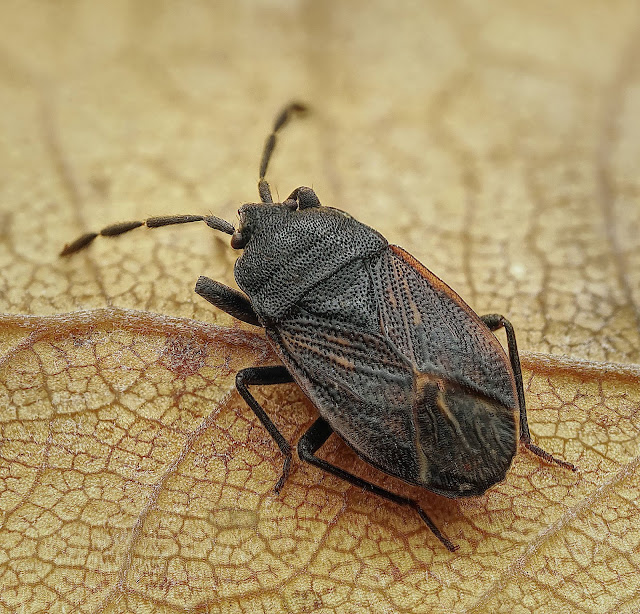Friday, 27 December 2024
FIT Count Summary 2024
Monday, 9 December 2024
Spider Surprise
A cold December day, half the countryside under water - what else to do but huddle over a nice warm microscope catching up with samples from the summer bulge when it is just impossible to keep up. In this case, a streamside vacuum sample from September. It started off in a humdrum way, knee deep in Bathyphantes gracilis and Tenuiphantes tenuis, but then ... a tiny speck of a spider turned out to be the Ray Spider, Theridiosoma gemmosum. I've never seen this species before and it's the first record for VC55 as well as a considerable range expansion. Fortunately it's a pretty unmistakable species (once you look close enough), which is lucky as this was an immature male - not surprising since September is past the peak for this species. A nice surprise on a winter's afternoon.
Sunday, 1 December 2024
Entomology Journal - November 2024
Winter has arrived, entomology slows down.
Bluesky
There are social media people and non-social media people. If you're one of the latter you might want to read on - old dogs and news tricks, etc. I had a long history on the Twitter social network, including academic publications. At first I couldn't get my head around Twitter - how could something so trivial be of value? The value of course is in the conversations which happen in the network. I fell out of love with Twitter some time ago, but couldn't face leaving. In the end, I didn't leave Twitter, it left me - sometime before it became "X". I haven't missed it, solely because I now have a new and much better network. Naturalists (and other communities) have flocked to BlueSky - https://bsky.app/ - and it's already helped me with identifications, as well as simply giving a sense of belonging. I hope you will join me there and become part of my network - https://bsky.app/profile/ajcann.bsky.social If you need any help getting started, just ask. If you would like to know more about BlueSky, there's a good article in Nature here.
Pygmy Backswimmer, Giant Headache?
Although small, the Pygmy Backswimmer, Plea minutissima, was always an easy tick - there's nothing else like it. Well now there is. A new paper describes another species (Plea cryptica sp. nov.) found across Europe, but not so far in the UK. It's highly improbable that it's not here, so now we've got to check them all - not an easy task. Raupach, M.J., Charzinski, N., Villastrigo, A. et al. The discovery of an overseen pygmy backswimmer in Europe (Heteroptera, Nepomorpha, Pleidae). Sci Rep 14, 28139 (2024)
Also:
My Journal, November 2024
01.xi.2024
Gave the moth trap a run but only three Light Brown Apple Moths, zero bycatch. Doesn't justify the electricity so I think that's it for me now until the spring.
02.11.2024
A trip to Loddington to sieve the leaf litter. Nothing amazing found but nice to be out in spite of the drizzle.
05.xi.2024
Visited Loughborough Cemetery to check the Mistletoe. Little found sadly.
12.xi.2024
Took a trip to Bardon Hill to sift some leaf little. Arthropods were hard to find, but nice to be out.
16.xi.2024
A lovely visit to Launde Park Wood. Although bugs were in short supply I was happy to sit in the sun and drink coffee. The highlight of the trip turned out to be tiny yellow fungus cups on a dead log. I assumed these were Lemon Disco, Bisporella citrina, but one of my Bluesky friends pointed out to me that the adjacent black fruiting bodies are pyrenomycete fungi, probably Rosellinia species. This means the yellow one is actually Sulphur Disco (Calycina claroflava, formerly Bisporella sulfurina), which parasitises the mycelium of pyrenomycetes.
19.xi.2024
Winter arrives, bringing snow. Bugs are huddled up.
22.xi.2024
I ventured out to Billesdon to try to find some aquatic bugs. Plenty of snow on the ground and I had to break the 1cm thick ice on the pool. Underneath, I found lots of Notonecta viridis and also abundant Corixids happily overwintering and unbothered by the cold. Among the species I found was a specimen of Callicorixa praeusta parasitised by the larva of a Hydrachna water mite (link above).
26.xi.2024
A rare sunny day. The Winter Gnats are dancing. I've tried to net these in the past to check the species but they always elude my clumsy efforts. Took a trip to Brocks Hill to take advantage of the sunshine but very few invertebrates around. A single Drymus reyei under a log was a nice find.



